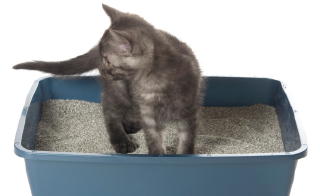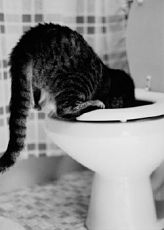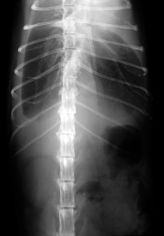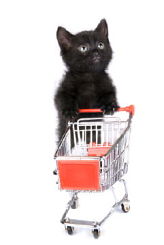Feline Lower Urinary Tract Disease

There are a number of names for feline lower urinary tract disease (FLUTD) such as those listed by Carl A. Osborne, DVM, PhD, a Diplomate of the American College of Veterinary Internal Medicine, in his 1999 journal article. He listed cystitis-urolithiasis, urethroadenocystitis, urethrosteriosis, cystitis-urethral obstruction complex, feline urethral obstruction, feline urologic syndrome, lower urological complex, feline uroligic complex and the list goes on. For the sake of simplicity we will refer to all of these as FLUTD or feline lower urinary tract disease.
The symptoms are often a clue. Your cat enters the litter box, scratches around frantically, appears to urinate due to the position its in, but exits the litter box only to return and repeat the process a few minutes later and this repetition continues as your cat tries to urinate but is lucky to have a few drips. What little urine is produced contains traces of blood. If your cat is suffering the symptoms of feline lower urinary tract disease he may need immediate intervention to save his life.
The Stages of Feline Lower Urinary Tract Disease
There are two stages of feline lower urinary tract disease. In the first stage, the cat develops inflammation of the bladder. The signs of this are straining to urinate, bloody urine, inability to produce significant amounts of urine, inappropriate urination, excessive licking of the urethra.
In the second stage, the cat develops urethral obstruction. The signs are depression, weakness, vomiting, and collapse. However, not all cats with feline lower urinary tract disease get obstructed. Urethral obstruction is the most sinister manifestation as it can quickly lead to uremic poisoning (toxic build up of internal wastes), renal failure, and ultimately death.
If your cat can't urinate...this is an extreme emergency. Get your cat to the vet right away. You only have one to two hours in which to save your cat. Your vet will probably put a catheter into his bladder to flush out the obstruction. The catheter is left in place for a day or two while the cat is placed on intravenous or subcutaneous fluids and a modified diet to dilute the urine and break down the bladder obstruction. After the catheter is removed your vet will probably keep your cat hospitalized for a few days to make sure it can urinate on its own.
The vet may also prescribe a muscle relaxant or antispasmodic to prevent involuntary spasms of the irritated urethra which may obstruct flow. He may use steroids to reduce the amount of inflammation of the urinary tract. In the event there is a bacterial infection, an antibiotic will be prescribed.
For severe or recurring cases a male cat might undergo a urethrostomy, a procedure in which the urethra is surgically shortened and opened up to a wider area to prevent blockage. This procedure also increases the cat's risk of infection so it is done only in severe cases.
Cystitis (urinary tract infection) is an inflammation of the lining and wall of the urinary bladder. It can be caused by infectious agents, abrasion of microscopic mineral crystals or uroliths (visible stones), or bladder distention due to a blocked urethra. Once inflamed the bladder begins to shed cells or mucus which can bind with minerals to form plugs that then block the urethra.
Urethral blockage is the obstruction of the urethra by uroliths or plugs made of mineral and organic composites which prevent the cat from passing urine. Uroliths are formed when excessive levels of a certain mineral, usually obtained through diet, form a solid crystal or stone.
The most common crystals are struvite, composed of magnesium ammonium phosphate and calcium oxalate. Other minerals will crystallize in high concentration, but such cases are rarer. When the cat can't urinate due to blockage of the urethra, usually only a small portion of the material plugging the urethra is struvite. The rest is mostly paste-like organic matter.
A vet has to figure out what the uroliths are made of in order to adjust the cat's diet. A diet low in magnesium inhibits struvite formation. Some commercial cat foods are, therefore, specially made for cats with FLUTD and have low levels of magnesium and ingredients that produce a slightly acidic urine. Your vet will have to be consulted before placing your cat on one of these diets because there may be other factors involved whereby you have to avoid that special diet.
Females have shorter and wider urethras and almost never get blocked. When they suffer from feline lower urinary tract disease, their symptoms are usually restricted to frequent bloody urination. Males are more prone to blockage. The diet for a cat prone to stone formation depends upon the type of stones being formed.
Uremic poisoning is caused by prolonged urethral blockage resulting in the body's inability to rid itself of toxic wastes in the urine. A cat can die of uremic poisoning within 24 hours from the time of blockage so getting the cat to the vet is mandatory.
There are many factors that contribute to feline lower urinary tract disease (FLUTD) but they can be broken down into two categories...infectious and noninfectious. Infectious agents only impact a system that is already weak and isn't strong enough to repress them.
Bacterial infections will take advantage of a system weakened by an underlying cause. You have to get to the cause or after defeating the infection it will just return.
The mineral content of a cat's diet can have a direct relationship with the formation of uroliths. What is essential is the saturation level of various minerals in the urine. Cats with extremely alkaline urine require a diet low in magnesium to achieve greater acidity in the urine.
The acidity helps break down crystals. However, oftentimes the lower magnesium promotes calcium oxalate crystals so it is imperative to work with your vet to find the right balance.
Other FLUTD risk factors are situational stress like a move or a new family pet can weaken a cat's immune system making them more vulnerable to infections. Obese cats also tend to have a higher rate of FLUTD because they are less active and don't empty their bladders as often. Heredity is another factor to be considered and a good example is the Himalayans which are at risk for calcium oxalate stones.
Once your cat is in better health, monitoring his diet is the best way to maintain his lower urinary tract health. If uroliths are a problem, be especially sure to stick to a prescription diet and increase water intake. Feed moist, canned food. Pay attention to your cat's litter box activities for any recurrent symptoms.
Purina Hemalert
Back in April of 2000, Purina came out with a product that is available by prescription from your veterinarian called Hemalert. It is part of the Purina CNM Urinary Tract Disease Management Program which is designed to accurately diagnose and manage urinary tract problems.
It is not meant as a diagnostic tool for the pet owner alone, but in conjunction with your vet you can monitor and detect if there is a problem, especially if your cat has recurring or chronic feline lower urinary tract disease.
Hemalert is an additive that is mixed with the cat litter (can be used with scooping as well as clay and non-clay fillers) and it reacts by changing color from pink to blue if blood is present in the urine. This alerts owners and vets monitoring the cat's treatment for feline lower urinary tract disease, if there is still a problem or if kitty is on the path to wellness. You have to take care not to let bleach or household cleaners come in contact with the Hemalert or it will give false positives.
For more information on Hemalert you can call 1-800-879-1266 weekdays from 8 a.m. to 4 p.m. or ask your veterinarian.
There is another product available without a prescription which is useful as a sickness indicator for problems other than feline lower urinary tract disease called Pet Ecology Scientific Professional Cat Litter. It's a bit pricey at about $10 a bag. It comes in 3 pound bags which are 70% lighter than clay and are the equivalent of 21 pounds of clay. A pink or red clump can indicate a bladder infection. I would alternate it with your normal litter, using it every few weeks or so to keep your costs down.
Perfect Litter Alert is an updated version/name but is pretty much the same as the patented litter aka Scientific Professional Cat Litter that monitors fluctuations in the cat's urine pH levels. High pH is an indicator of possible illness or urinary tract problems. High alkalinity can lead to health problems in most cats such as infection of the urinary tract, crystal formation, and even full blockage of the urinary tract which can be deadly.
For all natural cat litter click on the "Only Natural Pet Store" ad below...you will find litter even made from corn among other materials that are cat friendly.
Related Articles......
Return from Feline Lower Urinary Tract Disease to Cat Health Homepage
Having trouble finding what you need? Cat Health Index & Site Map
OR
Do you have a question to ask?...Questions
OR
Do you have a cat story to share?...Simply click here to go to that page!
Copyright@2010-2020 All rights reserved.Cat-health-detective.com
This website is information only. Consult a veterinarian for medical assistance

"Like Us" on Facebook
or...
"Like Us" here




















